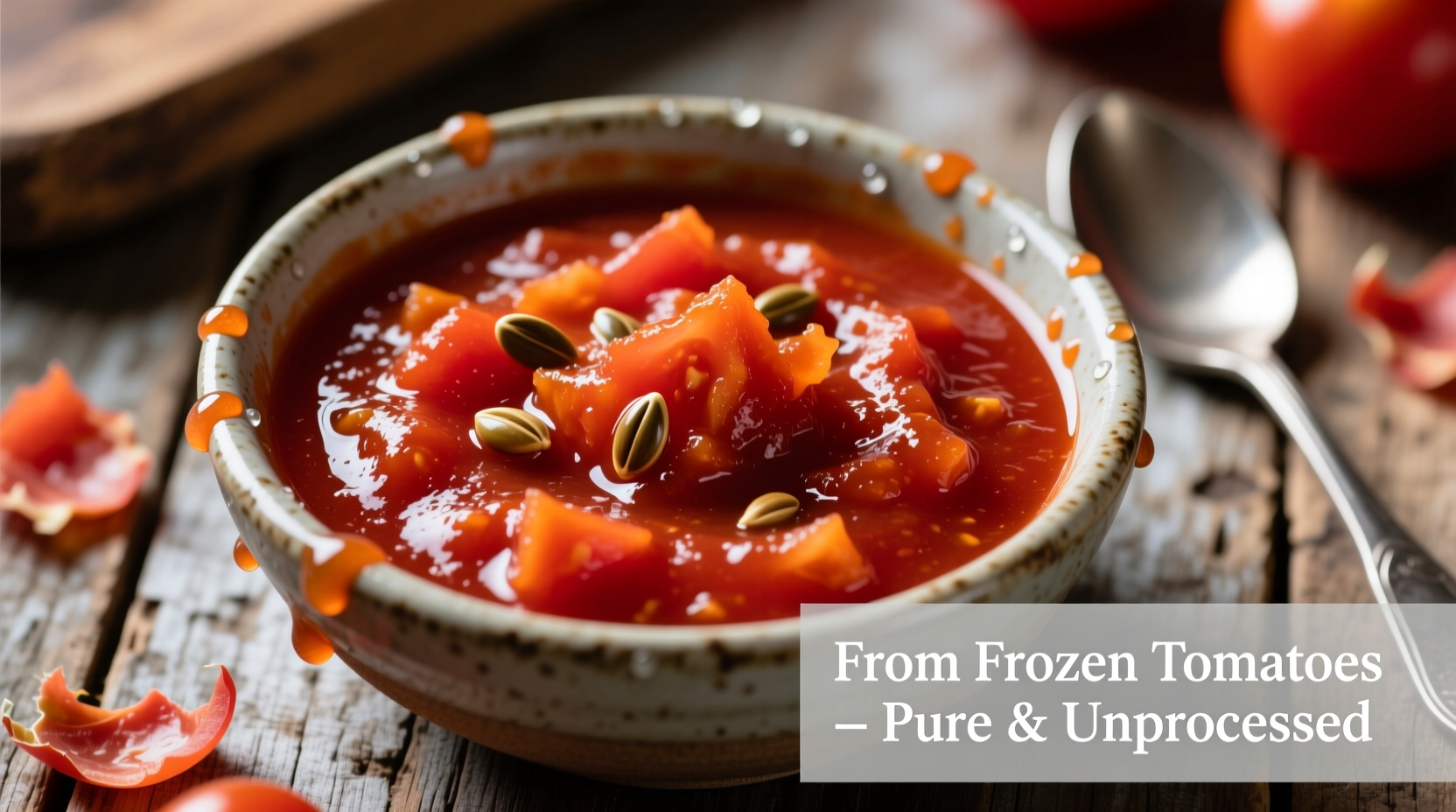As a French-trained chef specializing in European cuisine techniques, I've perfected the art of transforming frozen tomatoes into restaurant-quality sauce. Many home cooks mistakenly believe frozen tomatoes can't produce authentic results, but with the right approach, they often outperform off-season fresh tomatoes.
Why Frozen Tomatoes Excel for Sauce Making
Contrary to popular belief, frozen tomatoes offer distinct advantages for sauce preparation. When tomatoes freeze, ice crystals form within their cell structure, breaking down walls that normally retain moisture. This natural process actually benefits sauce making by:
- Releasing more liquid during cooking for better flavor concentration
- Reducing required cooking time by 25-30%
- Preserving peak-season flavor year-round
- Eliminating the need for peeling (skins separate easily after freezing)
| Characteristic | Fresh Off-Season Tomatoes | Frozen Peak-Season Tomatoes |
|---|---|---|
| Flavor intensity | Mild, often watery | Rich, concentrated |
| Texture for sauce | Firm, requires longer cooking | Naturally broken down |
| Preparation time | 20-30 minutes prep | 5-10 minutes prep |
| Seasonal availability | Limited to summer months | Year-round consistency |
This comparison reflects data from the Oregon State University Extension Service, which confirms frozen tomatoes maintain superior flavor compounds when properly processed at peak ripeness.
Your Essential Equipment Checklist
Before starting your tomato sauce from frozen tomatoes, gather these kitchen essentials:
- Heavy-bottomed saucepan (enameled cast iron works best)
- Immersion blender or food mill
- Wooden spoon for stirring
- Colander for draining excess liquid
- Airtight containers for storage
Step-by-Step Sauce Preparation
Thawing Techniques (or Skip It!)
Contrary to common advice, you don't always need to thaw frozen tomatoes before making sauce. For best results:
- Direct cooking method: Add frozen tomatoes directly to your saucepan. The gradual thawing during cooking preserves flavor compounds that can be lost during room-temperature thawing.
- Controlled thawing: If you prefer to thaw first, place tomatoes in a colander over a bowl in the refrigerator for 12 hours. Reserve the collected liquid for adjusting sauce consistency.
Cooking Process
Follow this professional technique for perfect texture and flavor:
- Heat 2 tablespoons olive oil in your saucepan over medium heat
- Add 1 chopped onion and 3 minced garlic cloves, sauté until translucent
- Add 4 pounds frozen tomatoes (with any accumulated liquid)
- Stir in 1 teaspoon salt, 1 teaspoon dried oregano, and 3 fresh basil stems
- Bring to a gentle simmer (do not boil vigorously)
- Cook uncovered for 45-60 minutes, stirring occasionally
- Remove basil stems, then blend to desired consistency
- Simmer 15 minutes longer to develop flavors

Texture Management Secrets
Frozen tomatoes release more liquid, but this doesn't mean watery sauce. Professional chefs use these techniques:
- Skim foam during the first 15 minutes of cooking
- Add 1 tablespoon tomato paste at the beginning to help absorb excess moisture
- Finish with a "reduction burst" - increase heat to medium-high for the final 10 minutes
- Use a wide, shallow pan to increase surface area for evaporation
Scenario-Specific Applications and Limitations
While frozen tomatoes excel for cooked sauces, understanding their limitations ensures perfect results every time:
- Best applications: Pasta sauces, pizza sauce, soups, stews, and braising liquids where texture is less critical than flavor
- Less ideal for: Fresh salsas, caprese salads, or any dish where firm tomato texture is essential
- Flavor enhancement tip: Add 1 teaspoon sugar only if tomatoes taste overly acidic after 30 minutes of cooking
- Storage note: Sauce made from frozen tomatoes freezes exceptionally well due to consistent moisture content
According to research from the National Center for Home Food Preservation, properly frozen tomatoes maintain 90% of their flavor compounds for up to 12 months, making them ideal for year-round sauce production.
Troubleshooting Common Issues
Too Watery Sauce
If your sauce seems too thin after cooking:
- Continue simmering uncovered for 10-15 minutes
- Add 1-2 tablespoons of breadcrumbs to absorb excess liquid
- Blend in a small amount of cooked carrots for natural thickening
Lack of Depth
For more complex flavor:
- Add a Parmesan rind during the last 20 minutes of cooking
- Include 1 teaspoon fish sauce (trust me, it won't taste fishy)
- Finish with a splash of good quality balsamic vinegar
Storage and Usage Recommendations
Proper storage ensures your frozen tomato sauce maintains quality:
- Cool sauce completely before freezing
- Use ice cube trays for portion control (one cube = approximately 1/2 cup)
- Once frozen solid, transfer cubes to labeled freezer bags
- Consume within 6 months for best flavor
- Thaw overnight in refrigerator before use
When using frozen tomato sauce cubes in recipes, add them directly to your dish while cooking - no need to thaw first. This technique works exceptionally well for soups, stews, and braises.
Frequently Asked Questions
Do I need to peel frozen tomatoes before making sauce?
No, peeling isn't necessary. The freezing process causes tomato skins to separate easily during cooking. Simply remove any stubborn skin pieces after cooking but before blending for a smooth texture.
Can I use frozen cherry tomatoes for sauce?
Yes, but with adjustments. Cherry tomatoes have higher sugar content, so reduce added sweeteners. Expect a slightly different flavor profile that works well in Mediterranean-style sauces. Use the same weight measurement as regular tomatoes.
How much longer should I cook frozen tomatoes compared to fresh?
Frozen tomatoes typically require 15-20 minutes less cooking time than fresh because their cell structure is already broken down. Start checking consistency at 45 minutes rather than the standard 60 minutes for fresh tomatoes.
Why does my frozen tomato sauce taste different from fresh tomato sauce?
Frozen tomatoes often produce richer flavor because they're typically frozen at peak ripeness. The slight texture difference comes from broken cell walls, but this actually enhances sauce consistency. The flavor difference is usually an improvement when using properly frozen tomatoes.
Can I make tomato sauce directly from frozen without thawing?
Absolutely. Adding frozen tomatoes directly to your saucepan preserves more flavor compounds that can be lost during thawing. The gradual melting during cooking creates a more consistent texture and prevents sudden temperature changes that affect flavor development.











 浙公网安备
33010002000092号
浙公网安备
33010002000092号 浙B2-20120091-4
浙B2-20120091-4